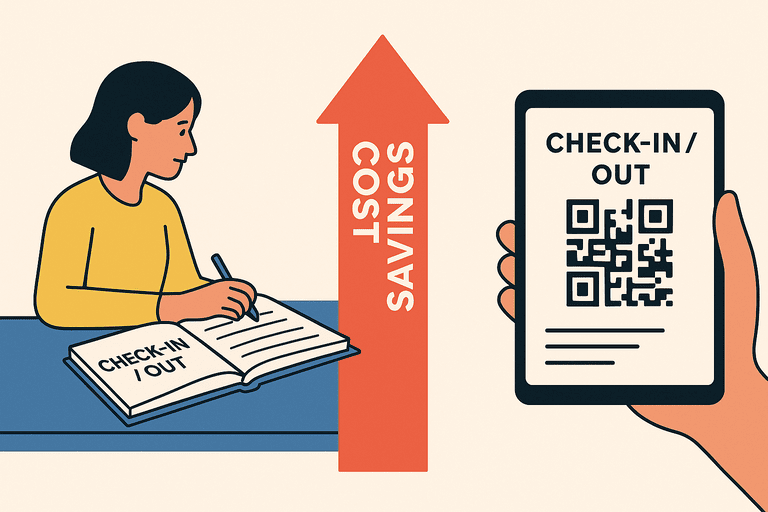The True Cost of Manual Check-In/Out Systems
Manual check-in/out systems waste time, increase errors, and cost businesses money. Learn the hidden costs and digital alternatives.

Introduction
Many businesses still rely on manual check-in/out systems — paper logs, spreadsheets, or verbal agreements — to manage shared equipment and assets. At first glance, these methods seem cheap and easy.
But the reality is different: manual systems introduce errors, create accountability gaps, and waste valuable staff time. Over the long term, they cost far more than businesses realize.
This article uncovers the true cost of manual check-in/out systems and why digital alternatives deliver better value.
What Are Manual Check-In/Out Systems?
Manual systems are traditional ways of tracking who uses equipment, tools, or spaces. Common methods include:
- Paper sign-out sheets at the reception desk.
- Shared spreadsheets updated by staff.
- Verbal communication between employees.
While these methods look inexpensive, they lack accuracy, accountability, and efficiency.
Hidden Costs of Manual Check-In/Out
1. Time Wasted on Logging
Employees must fill out forms or update spreadsheets. This process is slow, especially for frequent transactions.
- Cost impact: Lost productivity hours.
2. Errors and Inconsistencies
Handwriting issues, missed entries, and outdated spreadsheets cause mismatches between records and reality.
- Cost impact: Confusion during audits and incorrect reports.
3. Lost or Unreturned Items
Without strong accountability, items disappear — from laptops and projectors to workshop tools.
- Cost impact: Expensive replacements and frustrated staff.
4. Duplicate Purchases
When records aren’t reliable, businesses buy duplicates to “be safe.”
- Cost impact: Unnecessary capital expenses.
5. Compliance Failures
Industries like healthcare, finance, or education require clear audit trails. Manual systems rarely meet these standards.
- Cost impact: Fines, penalties, or failed audits.
6. Lack of Real-Time Visibility
Managers don’t know what’s available until records are updated. This delays projects and decision-making.
- Cost impact: Operational slowdowns.
Case Example: Small Engineering Firm
A 40-person engineering firm tracked tools with a paper log. Within 12 months:
- 12 drills and 3 laptops went missing.
- Staff wasted 300+ hours logging usage manually.
- Duplicate purchases cost $8,000.
After switching to QR-based check-in/out system:
- Missing tools dropped by 70%.
- Logging time was reduced by 80%.
- Audits went from days to hours.
Comparing Manual vs Digital Check-In/Out
| Feature | Manual System | Digital System (e.g., InvyMate) |
|---|---|---|
| Speed | Slow, handwritten | Instant QR scan |
| Accuracy | Error-prone | Automated, reliable |
| Accountability | Weak (hard to trace users) | Strong (every scan is logged) |
| Audit Readiness | Poor | One-click reporting |
| Scalability | Breaks with 50+ assets/users | Scales with thousands of items |
| Cost Over Time | Rising losses + labor | Subscription but huge savings |
The Real Cost Breakdown
Let’s quantify typical annual costs for a small business using manual check-in/out:
- Lost equipment: $10,000
- Duplicate purchases: $5,000
- Staff time wasted (200 hrs × $25/hr): $5,000
- Audit preparation & compliance issues: $3,000Total = $23,000 per year
Switching to digital:
- Software subscription: ~$2,000/year
- Savings in losses, time, and purchases: ~$15,000+
Net ROI: More than 600% annually.
Benefits of Digital Alternatives
- Faster logging: QR or barcode scans in seconds.
- Improved accountability: Each check-in/out tied to a person.
- Real-time visibility: Know instantly what’s available.
- Automated alerts: Overdue reminders and low-stock warnings.
- Audit-ready reports: Compliance in one click.
Best Practices for Transitioning Away from Manual Systems
- Audit your current check-in/out process.
- Tag every asset with QR/barcodes.
- Choose digital software suited for your team size.
- Train staff to scan instead of writing.
- Run a short transition period (manual + digital).
- Fully commit once adoption is smooth.
Common Mistakes to Avoid
- Delaying transition because “manual is cheap.”
- Only tagging high-value items while ignoring smaller ones.
- Failing to train staff properly.
- Running both systems indefinitely (creates confusion).
Conclusion
Manual check-in/out systems may seem cost-free, but they quietly drain money through lost assets, wasted staff hours, and compliance risks.
Digital solutions — with QR codes, mobile apps, and real-time dashboards — not only cut these hidden costs but also provide scalability and accountability.
The true cost of manual systems isn’t just financial — it’s the lost opportunity to run a faster, smarter business.
👉 Still using paper logs? Switch to InvyMate today — a digital check-in/out system that saves money, improves accountability, and makes audits effortless.